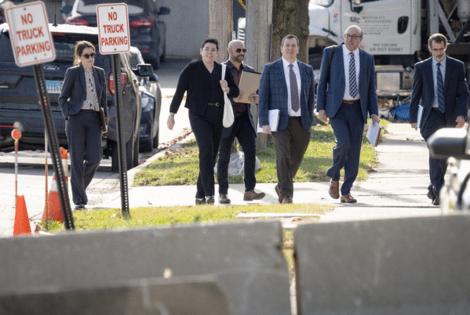Attorneys visit 'black box' ICE processing center in Broadview
Published in News & Features
BROADVIEW, Ill. — As a small group of protesters flanked a street leading to the U.S. Immigration and Customs Enforcement processing center in Broadview, a group of attorneys on Thursday completed a tour of the building, becoming some of the only outsiders in recent months to view the interior amid scrutiny over allegedly inhumane conditions.
The rare site visit was ordered by U.S. Magistrate Judge Laura McNally — who also attended the tour — in the wake of a class-action lawsuit alleging dirty, unsafe and overcrowded conditions at the west suburban facility. The complaint, filed on behalf of two former detainees, additionally accused officials of blocking access to attorneys while coercing detainees into agreeing to voluntary deportation.
In a statement following the visit, the attorneys said they will save “detailed observations” about the visit for upcoming legal filings and presentations.
McNally’s ruling allowing the visit was a significant win for the plaintiffs in an atmosphere in which immigration attorneys, members of Congress and faith leaders have all been turned away from the building, called a “black box” in the lawsuit. The attorneys could be seen entering the building a little after 11 a.m. and leaving after 3 p.m.
“We are grateful that the court gave us an opportunity to inspect the Broadview facility. We remain committed to ensuring that any detainees at Broadview are treated with dignity, have access to counsel, and are provided due process,” said the statement, made jointly by attorneys for MacArthur Justice Center’s Illinois Office, the ACLU Illinois and Eimer Stahl law office. “We encourage anyone detained at Broadview and lawyers facing complications communicating with their clients at the facility to let us know about problems at the facility.”
After a daylong hearing during which detainees testified about more than 100 people crammed into a holding cell with no room to lay down, U.S. District Judge Robert Gettleman found that conditions there do not “pass constitutional muster” and ordered a temporary restraining order that requires the Department of Homeland Security to provide bedding, clean spaces, soap and showers and enough food and water for detainees housed overnight.
With those requirements in place, attorneys for the plaintiffs were granted an inspection to verify that the order is being followed and gather evidence.
They were allowed to take photographs and talk to detainees during the tour, as well as bring in a translator and detention expert.
Outside the building Thursday morning, a woman livestreamed the visit on her phone, as onlookers waited for the group to walk inside.
Near an altar honoring Silverio Villegas-Gonzalez, who was shot and killed by ICE agents following a Sept. 12 traffic stop, protesters held signs proclaiming: “No more ethnic cleansing” and “Your mama is not proud of you!!!”
“Did you hide all the evidence before the judge came?” one protester shouted.
The temporary restraining order is the first measure to bring accountability to the facility, which attorneys have said operates like a “black site” where people have disappeared with few opportunities for contact with the outside world. The building has also become a flash point for frequent protests, where police and federal agents have clashed with demonstrators.
Immigration attorneys testified that they have not been allowed into the building to visit with clients, and have even had significant difficulties connecting with them by phone and even learning where they are housed.
In June, U.S. Reps. Jesús “Chuy” García, Delia Ramirez, Jonathan Jackson and Danny Davis were denied entrance.
Clergy members who have historically ministered to detainees have also been denied access.
Pope Leo XIV even weighed in, calling on the Trump administration to allow detainees to take communion.
Meanwhile, Gov. JB Pritzker celebrated the drawing down of immigration agents in Chicago, even as he acknowledged the uncertainty of what comes next. The Tribune reported earlier this week that Border Patrol Cmdr. Gregory Bovino was set to leave Chicago after a period of violent and chaotic arrests and clashes with community members.
“We’ll see what comes next, but I am not confident, I’ll be honest with you, that we’re going to see peace in our neighborhoods now,” he said. “I think there are just fewer agents, and that will probably ratchet it down to some degree. But I think unless they change their tactics, they’re going to end up in court again and again and again.”
_____
(Chicago Tribune’s Olivia Olander contributed to this story.)
_____
©2025 Chicago Tribune. Visit at chicagotribune.com. Distributed by Tribune Content Agency, LLC.







Comments